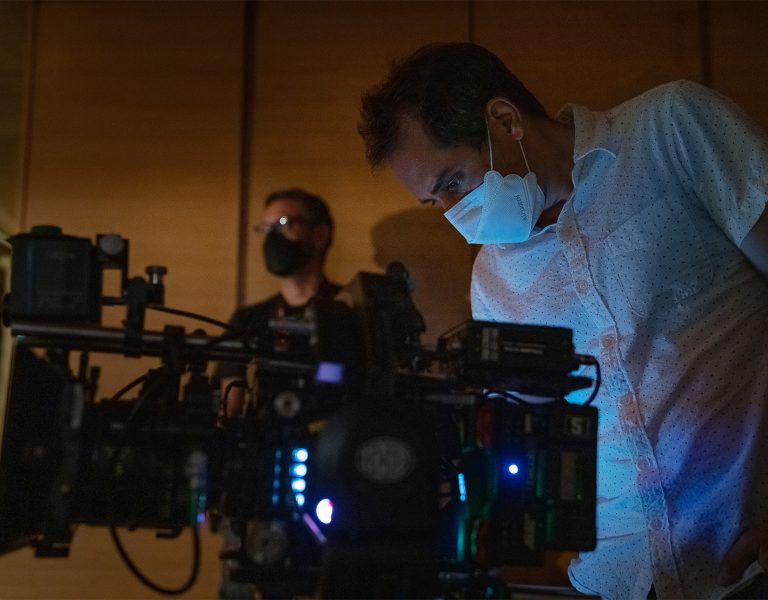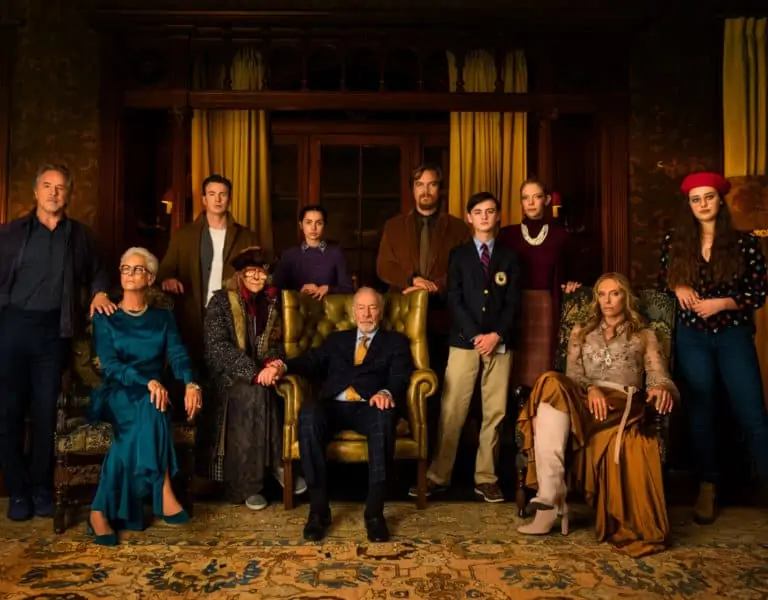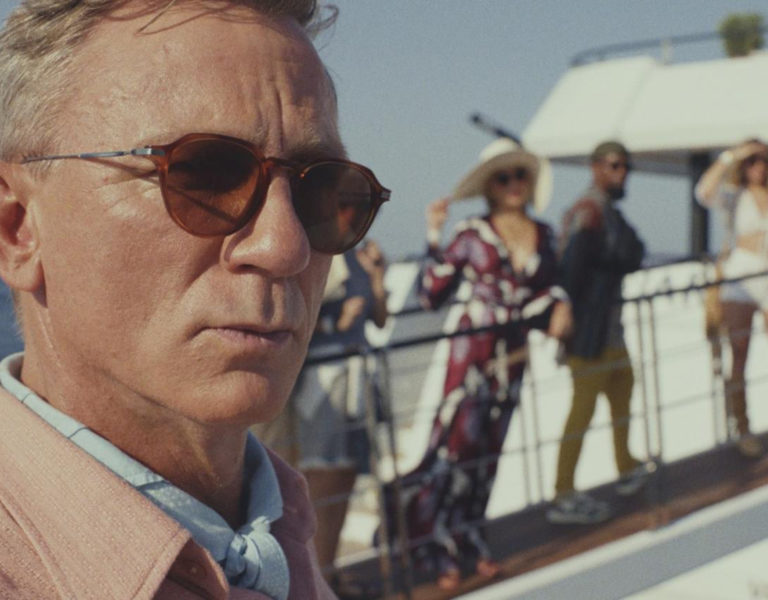LAYERS OF ATMOSPHERE
Benoit Blanc swaps Stateside for the Greek seaside in his latest mystery romp. Capturing Blanc’s every move with a similarly scrupulous approach to Daniel Craig’s detective was Glass Onion: A Knives Out Mystery’s cinematographer, Steve Yedlin ASC.
A mysterious invite from tech billionaire Miles (Edward Norton) lures a motley crew of friends to the sun-drenched Mediterranean, including a Southern-accented special guest. Daniel Craig’s stylish sleuth, Benoit Blanc, is back for more whodunnit hi-jinks in Glass Onion: A Knives Out Mystery following 2019’s original, which kicked the series off in style by marrying a starry ensemble cast with some classic mystery tropes. Not a typical sequel, Glass Onion crafts an entirely fresh adventure from its predecessor’s winning recipe with a host of brand-new characters.
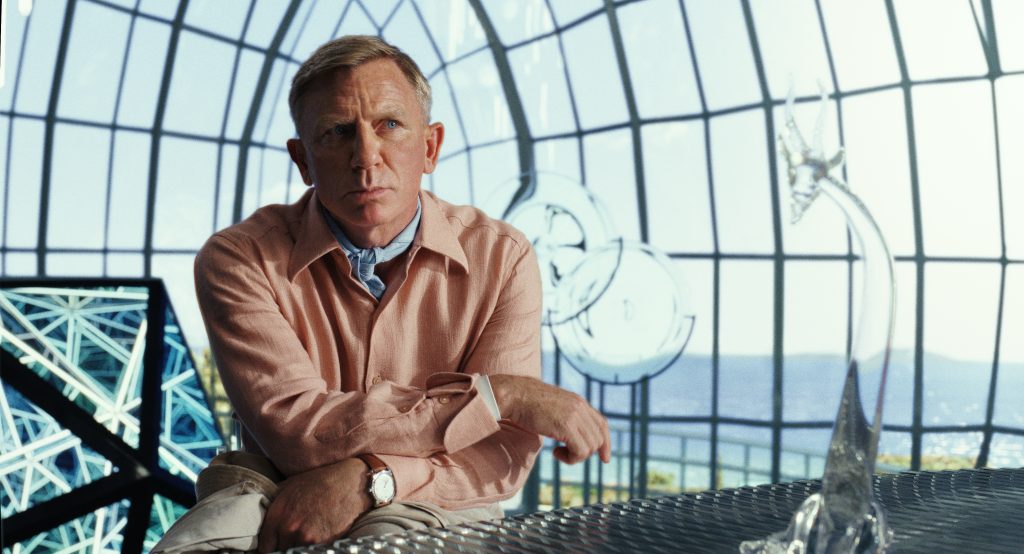
Returning to the Knives Out universe to lens Glass Onion is cinematographer Steve Yedlin ASC – although given his long-time collaboration with director Rian Johnson, it probably comes as little surprise. The pair spent their undergraduate years making short films together at USC’s film school – the beginning of a decades-long creative partnership. Highlights of their rich shared catalogue range from 2005’s Joseph Gordon-Levitt-fronted Brick, via Looper and Star Wars: The Last Jedi, through to Johnson’s upcoming Peacock series Poker Face.
Such a partnership has allowed the pair to hone their prep to a fine art. “Rian and I have been making films and talking about films together for so long that, with little exception, in prep we spend almost no time talking over abstractions of the overall approach – we just dig right into it and start designing actual shots and scenes,” Yedlin says. “[It’s] a really great use of prep time because we dispense with the vague ‘let’s just talk about this in a literary criticism way’ and we start rolling up our sleeves and designing the details of the visuals. It allows for prep to be really useful in ways that sometimes it isn’t on other projects, and we can hit the ground running. For example: we’re able to launch into the logistics of projects that might need a lot of development time on day one of prep instead of only just beginning to conceive of the projects at that point.”
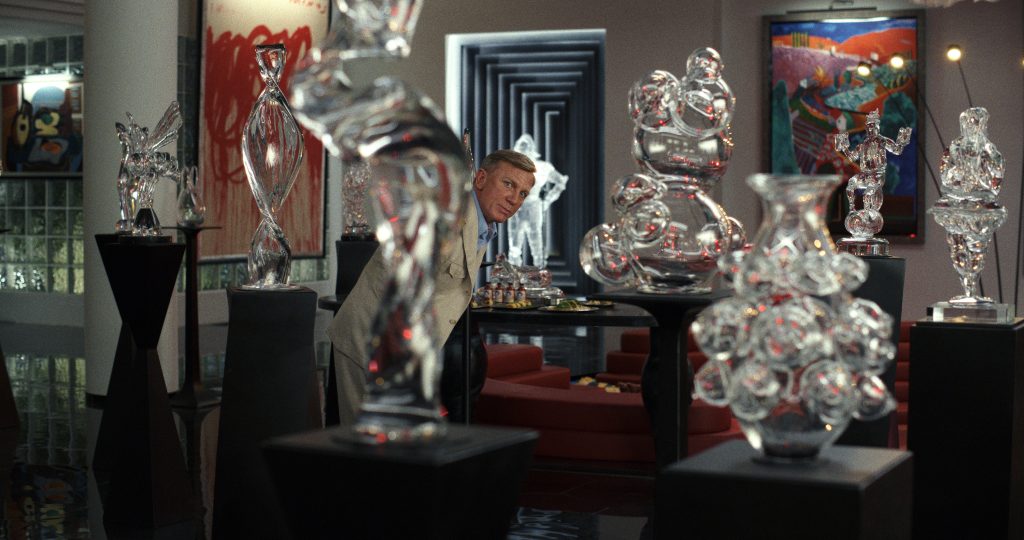
The DP adds, “Rian is a visual master and has a truly clear and confident vision, so that means I’ve got my work cut out for me. He confidently knows exactly what he wants up to the level of detail that a director would and should. But he doesn’t come at me, or any of the crew, with any micromanaging false precision beyond that point. That means we’re all working towards a very defined and unified goal with enough clarity not to spiral or waste time but with the freedom to use all our creativity however we see fit to make the film the best we know how.”
If Johnson is a visual master, then Yedlin is a technical one. Anyone who has followed his #NerdyFilmTechStuff Tweets or lost an hour (or five) on his website will know of the DP’s devotion to the science of cinematography. His colour pipeline has been developed over many years and its current iteration is tailored to the Alexa, which meant it was an obvious choice for Glass Onion. Working with Panavision London, he teamed the ARRI Alexa Mini LF – also used on Knives Out – with ZEISS Supreme Prime lenses and Cinema Zooms.
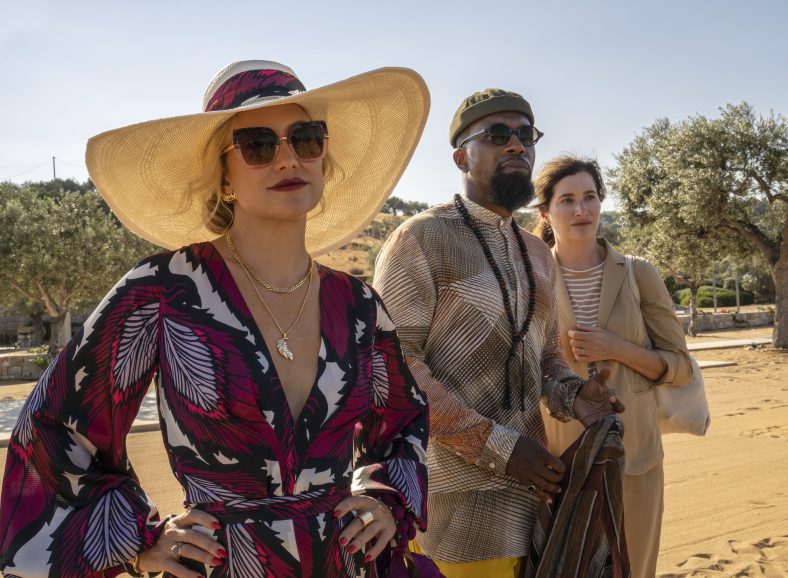
Long, hot summer
Glass Onion’s shooting schedule was split between Greece and Serbia in the ultra-hot summer of 2021, with an on-site PCR testing hub helping the production avoid a single COVID shutdown even during the aggressive Delta surge. In the Greek Peloponnese, Villa 20 was the suitably striking real-life setting for Miles’ fictional billionaire’s playground in the film. Production designer Rick Heinrichs had toured the villa early in pre-production but wanted somewhere closer to water. After six weeks of scouting, however he didn’t find anywhere that matched the villa’s aesthetics and ultimately returned to it. The island of Spetses played for scenes on mainland Greece, while interiors were constructed on soundstage in Belgrade included the artsy atrium and the interior of the glass onion itself (the exterior being VFX).
The film was shot at a latitude and time of year when the sun is high for most of the day. Yedlin discusses steering the feel of the sultry Greek day exteriors away from harsh pounding sun and towards an inviting sun-baked look. “This was a compressed schedule: we had to shoot exteriors all day and didn’t have the luxury of waiting to shoot only at low sun,” Yedlin notes. “We had plenty of instances of having to shoot in high sun that’s often a cinematographer’s enemy. But rather than struggling to counteract it, I wanted to figure out a way to lean into it and to make it warmly evocative of that Greek, sun-drenched look.
“The solution was in a combination of approaches and techniques, including: avoiding trying to overcome the sun with big lights unless it was an instance where we were confident it wouldn’t look forced or distracting, filling in subtly with bounced light, using remote iris pulls during evolving shots, selective use of lens filters that reduce contrast without blurring, and a confident but not heavy hand in colour grading. This all went together with discussions Rian and I had in prep with costume designer Jenny Eagan and the gang about embracing hats and sunglasses which, besides making the cast more comfortable in the blazing sun, would give us interesting shadow interplay.”
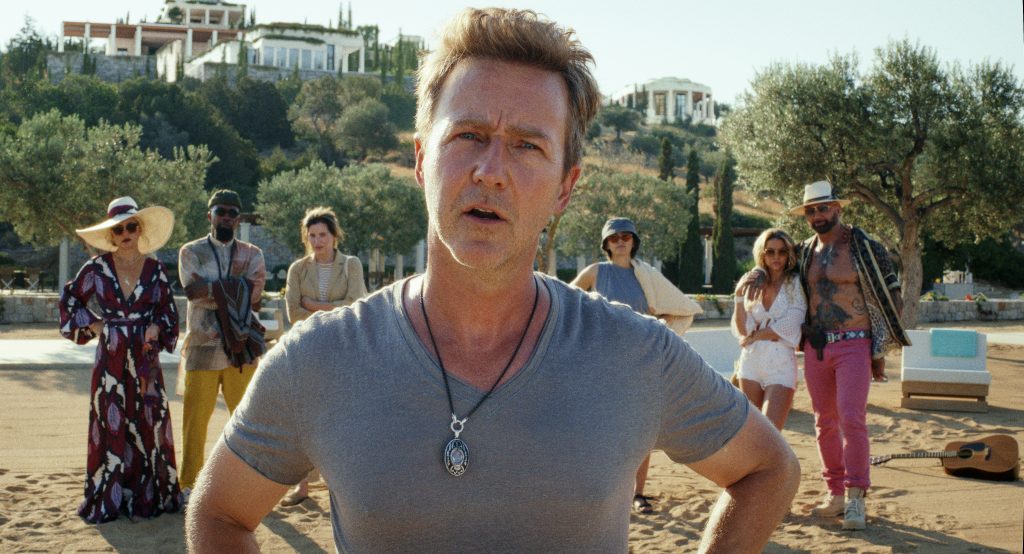
Lighthouse sweeps
Glass Onion features a film-noir-esque sequence in which the entire island is plunged into darkness, broken at intervals by the dazzling sweeps of light from a nearby lighthouse. A puzzle that Yedlin relished solving, along with gaffer Carlos Baker and key grip Pat Daily, was how to build a rig for the lighthouse’s sweeping beams that could deliver the heightened theatricality Johnson sought while offering fine, agile adjustability and confident repeatability.
The design of the lighthouse rigs began as early as Yedlin’s first day of prep. “It was a whole interdepartmental effort to engineer both the physical and software aspects,” he explains. Merely panning a light over the scene was not an option for many reasons including the lack of definition at the beam edges, light that would bounce back onto the set when it was pointed away, the winding up of cables, and the clunky imprecision of manual panning.

Yedlin adds: “We were going for theatricality, not realism: in reality, the sweep of a lighthouse would be so geographically large that within the limited view of the frame it might feel more like a fade than a sweep, but we wanted the audience to get a strong visceral sense of that light beam making progress within screenspace. And we needed to be able to meticulously design the timing for each shot, so that it would hit on precise dramatic cues on every take.
“Because every shot had its own unique demands, we needed to adjust various aspects of the timing separately: we needed the ability to adjust the speed of travel of the sweep separately from the time interval between the sweep-on and the sweep-off. On top of the demands of timings and distances varying shot-to-shot, we also needed precise programmability because we had many instances where two or even three lighthouse rigs were working together to give the illusion of a single sweep of the beam. So, for one to dovetail seamlessly into the next, we needed precise and repeatable control over the exact offset of both time and position between the several rigs.”
The solution was found in shrouding large fresnel lighting units with custom fabricated drums with adjustable apertures whose rotation was driven by DMX-controlled motors. The drums and drive mechanisms were designed by Daily and custom control software was written by Yedlin himself and a frequent collaborator Eric Cameron. Implementation of the rigs on location and stage was a coordinated effort of the entire grip and lighting departments.
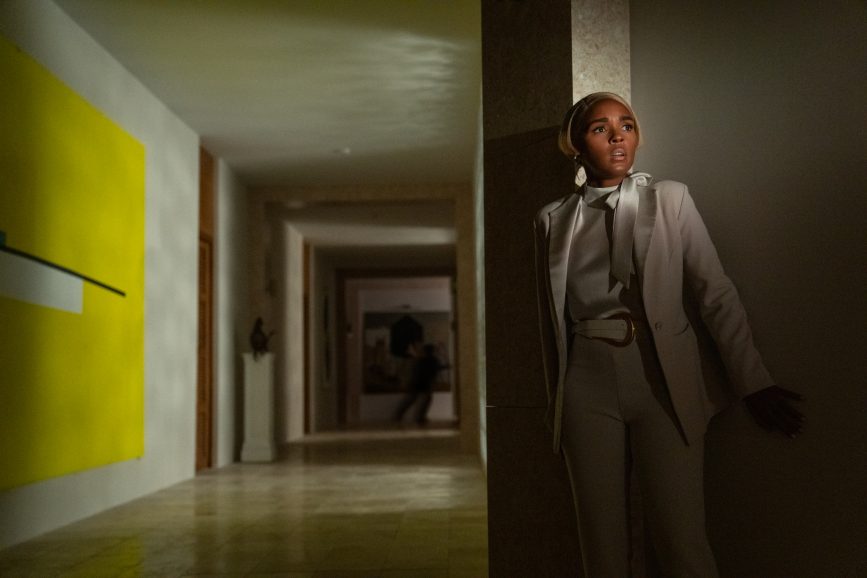
Lighting the atrium
Yedlin explains that another challenge that flexed the creative muscles was keeping the lighting interesting and dramatic in the atrium set, where some 30 script pages take place in an unchanging cavernous environment that had no motivated light either from the windows or from practicals on the ground. “The only substantial motivated light visible in that space was chandeliers on the extreme edges, so we had to embrace the idea that the bulk of the lighting in there, especially in the centre of the huge space, was going to be, at least to an extent, unmotivated and purely dramatic. So we tried to strike a balance between on the one hand giving the space a distinct recognisable look while on the other hand changing things up between dramatic beats: for example subtly shifting the emphasis from side-light to top-light from one scene to the next while not going so far as to lose the larger sense of continuity.”

Another fun interdepartmental effort was the scenic horizon beyond the windows in the atrium set. “I’d taken some just-after-dusk photos during our initial scout of the villa that captured a distant, completely silhouetted land mass against a dim but rich blue sky,” Yedlin recalls. “It was not only beautiful and real for the location but if used in the movie would also underscore the remoteness of the island, since the inky blackness and lack of lights tells the audience that the part of the mainland that’s closest to the island is not populated. So I proposed to Rian going for this look and achieving it with a scenic horizon instead of visual effects. So we get the art, grip, and lighting departments together and created a large painted scenic cutout that spanned the entire set and beyond. It was matte black where the dark land mass was supposed to be and a dark grey where the sea was. Behind the cutout horizon was a huge seamless black textile that we lit with a rich blue to be the gently glowing sky that our land was silhouetted against.”
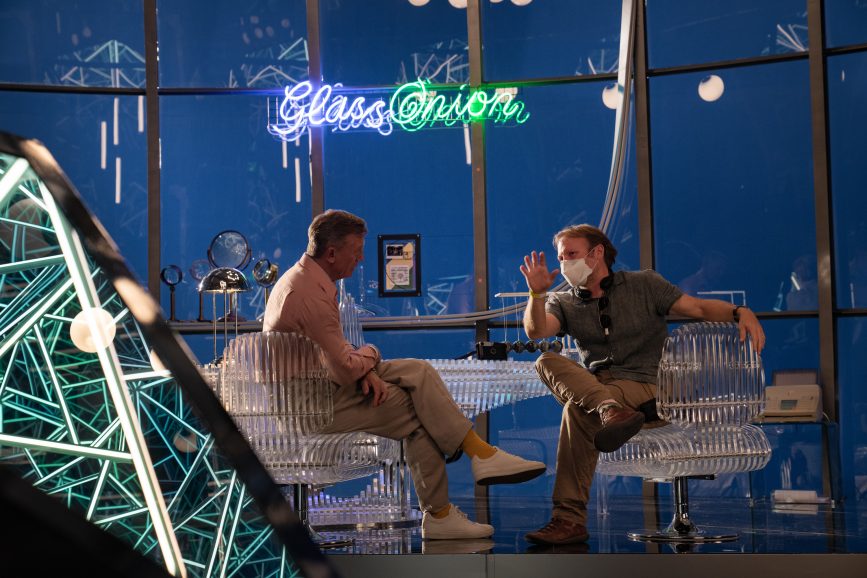
Yedlin returned to a frequent collaborator, FotoKem veteran Philip Beckner, for the grade. They adopted the same overall approach as for Knives Out. “Phil has a really great eye for getting skin tones and overall balance into a beautiful spot very quickly,” he says. “We have this colour pipeline that’s really buttoned up and figured out so that there’s just one LUT and we don’t have the foundations shifting under our feet from shot to shot. The movie has a base look where everything really does overall look like what we want it to look like. That allows the colourist to really use all the time they have on finesse work and what they’re good at.”
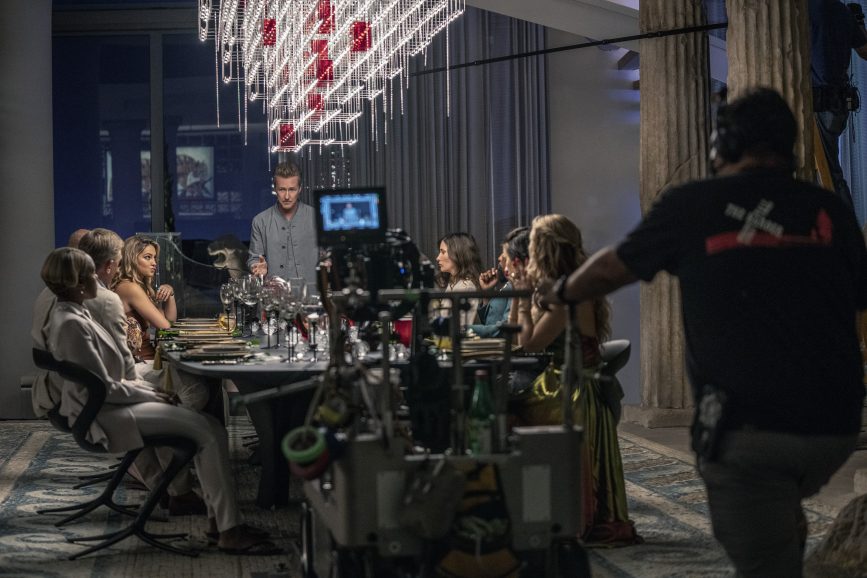
Bringing Benoit Blanc across the Pond was no small feat, especially in the COVID era. Yedlin highlights the work of second unit DP Jaron Presant ASC, for whom he’d once gaffered on commercials straight out of film school. “But the whole crew was fantastic,” he notes. Jeremy Braben Assoc. BSC’s Helicopter Film Services were on hand to capture the idyllic Greek scenery, shooting with an Angénieux EZ2 15-40 T2 zoom lens as requested by Yedlin. An Airbus H125 helicopter with a Shotover F1 gimbal rigged with an Alexa Mini LF and Fujinon 28-100mm Premista lens was used for the superyacht sequences as well as VFX plates and photogrammetry for the island establishing shots.
Fans of the series will be delighted to hear a third Knives Out Mystery is in the works, with more hopefully on the way. As Rian Johnson told the TIFF 2022 audience: “I’ll do that until Daniel (Craig) blocks me on his phone.”


